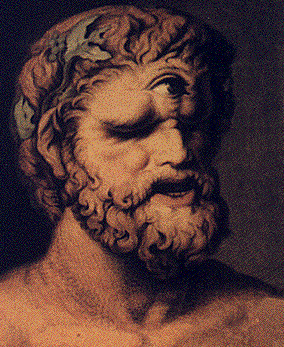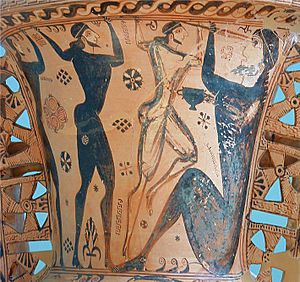Polyphemus facts for kids
|
Johann Heinrich Wilhelm Tischbein's 1802 head and shoulders portrait of the giant
|
|
| Grouping | Cyclopes |
|---|---|
| Region | Sicily |
Polyphemus (Greek: Πολυφήμος, translit. Polyphēmos Latin: Polyphēmus) is a famous one-eyed giant from Greek mythology. He is the son of Poseidon, the god of the sea, and Thoosa. Polyphemus is one of the Cyclopes, a race of giants with a single eye. He appears in Homer's epic poem, the Odyssey. In this story, he is a wild giant who eats people. Later writers also described him as a talented musician.
Contents
Odysseus Meets the Giant Polyphemus
In Homer's epic story, Odysseus was sailing home from the Trojan War. He landed on an island where the Cyclopes lived. Odysseus and some of his men found a cave full of food. This cave belonged to the giant Polyphemus.
When Polyphemus came home with his sheep, he blocked the cave entrance with a huge stone. He did not follow the usual custom of hospitality. Instead, he grabbed two of Odysseus's men and ate them. The next morning, the giant ate two more men. Then he left the cave to let his sheep graze.
Odysseus's Clever Plan
That evening, Polyphemus returned and ate two more men. Odysseus then offered the giant some very strong wine. It was undiluted wine that Odysseus had received earlier. The giant asked Odysseus for his name. He promised a special guest-gift if Odysseus told him.
Odysseus cleverly said his name was "Nobody". Polyphemus promised to eat "Nobody" last of all. After drinking the wine, the giant fell into a deep, drunken sleep.
While Polyphemus slept, Odysseus heated a wooden stake in the fire. He then drove the hot stake into Polyphemus's eye. The giant screamed for help from his fellow giants. He shouted that "Nobody" had hurt him. The other giants thought he was suffering from a god's power. They told him to pray instead.
Escaping the Blind Giant
In the morning, the blind Cyclops let his sheep out to graze. He felt their backs to make sure no men were escaping. But Odysseus and his men had tied themselves to the undersides of the animals. This way, they managed to sneak out of the cave.
As Odysseus sailed away with his men, he made a big mistake. He proudly shouted his real name to the giant. This act of hubris (extreme pride) caused him problems later. Polyphemus prayed to his father, Poseidon, for revenge. He threw huge rocks towards Odysseus's ship. Odysseus and his men barely escaped.
Polyphemus in Art
Artists have shown the story of Polyphemus for a very long time. In the 600s BC, potters often painted scenes from the Odyssey. Almost half of these paintings showed the blinding of the Cyclops. They also showed how Odysseus and his men escaped. One vase painting, showing a hero under a sheep, was even used on a Greek postage stamp in 1983.
The blinding of Polyphemus was also shown in large sculptures. One giant sculpture of Polyphemus was found in the Sperlonga sculptures. These were likely made for the Roman Emperor Tiberius. Later Roman emperors like Claudius and Nero also had similar artworks.
Many European painters have also shown Polyphemus. The Flemish artist Jacob Jordaens painted Odysseus escaping the cave in 1635. Other artists chose to show the giant throwing boulders at the escaping ship. In Guido Reni's painting from 1639, the angry giant pulls a boulder from a cliff. Odysseus and his men row far below.
Polyphemus is often shown with two empty eye sockets and a damaged eye in the middle of his forehead. This way of showing him comes from ancient Greek art. It can be seen in Johann Heinrich Wilhelm Tischbein's 1802 portrait of the giant.
Arnold Böcklin painted the giant standing on rocks. He is swinging a rock back as the men row hard over a big wave. In Jean-Léon Gérôme's 1902 painting, Polyphemus stands on a cliff. He has already thrown one stone, which just missed the ship. The reason for his anger is shown in J. M. W. Turner's painting, Ulysses Deriding Polyphemus (1829). In this painting, the ship sails forward as the sun rises. The giant is a shadowy shape high above.
Similar Stories Around the World
Stories like Homer's Polyphemus tale are found all over the ancient world. In 1857, Wilhelm Grimm collected versions of this story. They came from places like Serbia, Romania, Estonia, and Germany. More than 200 different versions have been found. They come from about 25 countries. These countries stretch from Iceland to Korea. Experts believe these "Polyphemus legends" are older than Homer's story.
For example, there is a story from Georgia in the Caucasus mountains. It tells of brothers held captive by a one-eyed giant shepherd called "One-eye". The giant roasts and eats all but two of the brothers. The remaining two heat a spit until it is red hot. Then they stab it into the giant's eye. As One-eye lets his sheep out, he feels each one. But the two brothers escape by covering themselves with a sheepskin.
Interesting Facts About Polyphemus
- His name means "abounding in songs and legends" or "very famous".
- The Polyphemus moth is named after him. This is because of the large eye-like spots on its hind wings.
- A type of burrowing tortoise, Gopherus polyphemus, is also named after Polyphemus. This is because both use underground homes.
- In the study of folktales, the story of blinding Polyphemus is called Polyphemsage.
Images for kids
-
Arnold Bocklin, Polyphemus attempts to crush the boat of the escaping Odysseus.
-
Nicolas Poussin's pastoral "Landscape with Polyphemus", 1649.
-
Ulysses Deriding Polyphemus is an 1829 oil painting by Joseph Mallord William Turner. Polyphemus is disguised behind one of the mountains on the left side.
See also
 In Spanish: Polifemo para niños
In Spanish: Polifemo para niños








